Consequences for HIPAA violations can often be quite harsh. If someone has breached the HIPAA privacy regulations – even without any malicious intent, civil penalties are applicable: $100 per violation for unawareness, a minimum of $1,000 for reasonable cause, a minimum of $10,000 if willful neglect is present and then rectified, and finally, a minimum of $50,000 for individuals who act with willful neglect and ignore the issue.
| Digital ExclusiveEsogetic Colorpuncture: A Complete Aculight Therapy System for Body, Mind and Spirit
Use of colored light as a treatment modality is a rapidly growing area of experimentation for many acupuncturists. Used either to complement or replace traditional needling techniques, practitioners are finding that treatment of acupoints with colored light adds new dimensions to their work. Light offers a gentle, pain-free, noninvasive therapeutic alternative with no side-effects. Many light therapies may be continued at home by the patient, thereby reducing treatment costs. In addition, light exhibits a unique capacity to effect psychological and spiritual healing while simultaneously supporting physical healing.
Esogetic colorpuncture is a complete system of aculight therapy developed over the past 25 years by German naturopath and acupuncturist Peter Mandel. It combines concepts of acupuncture with the latest research on the way light functions in the body coming from the field of modern biophysics. Like acupuncture, colorpuncture presupposes that the balanced flow of energy through the meridian system will support good health. However, colorpuncture achieves this by introducing vibrational information into the body in the form of different colored light frequencies via the meridian system.
For these treatments, a hand-held aculight pen with insertable colored glass tips is used. The tool emits incandescent light and is battery-operated. Each colored tip is precisely set at a specific frequency within the frequency band for each color. Colorpuncture treatment consists of particular sets of points treated in sequence with specific colors. Treatment points are derived from traditional acupuncture; other holographic grid systems such as reflexology and applied kinesiology; and many points discovered by Mandel in his clinical practice.
History and Development of Esogetic Colorpuncture Therapy
Starting in the 1970s, Mandel began integrating theoretical and empirical data on the effects of color, the philosophy of Chinese medicine and the latest findings of modern photon physics. A lengthy professional association with German biophysicist Fritz Albert Popp provided Mandel with the theoretical basis for his work. In his studies of human cell communication, Popp demonstrated that normal living cells emit a steady stream of photons (particles of light) called biophotons. Popp hypothesized that these act as carriers of information in living organisms, and that a cell will show an increase emission of biophotons (and disturbed information flow) whenever its functions are no longer in a state of balance. Further, the change in the biophoton emissions of one cell will eventually disturb the biophoton emissions in neighboring cells (imagine a pebble dropped in a pond with its spreading ripples). This change from harmoniously oscillating light eventually leads to incoherence and disease.1 Mandel went one step further by suggesting that these cellular changes also eventually affect the electrical receptivity of related zones and acupoints on the surface of the skin.
Given that human cells exhibit energetic properties of light, and that light and color have a modifying effect on the body's system of energetic information, it seemed obvious to Mandel that the informational properties of light and color could be used to restore coherence and health. Furthermore, given his training in acupuncture and the existing research indicating that meridians actually channel light, Mandel felt that the system of acupuncture, with its skin points of meridians, was the best means of introducing light into the energetic anatomy. Through extensive experimentation, Mandel determined that certain acupoints displayed a particular affinity to certain colors. Starting with the basic primary and secondary colors (red, green, blue, orange, yellow and violet), he developed treatments using these complementary (warm and cool) colors to balance bipolar acupoints. This, he said, was the birth of colorpuncture and allowed for a highly differentiated means of affecting the yin-yang balance between complementary pairs of points.2
Since then, Mandel has continued to explore the therapeutic potential of various colors. He developed the "soul-spirit" colors (rose, pale turquoise, light green and magenta), which are used for more psychological treatments. He uses a specific frequency of infrared light for his pain relief treatments. Most recently, he has developed therapies using three shades of gray light, as well as ultraviolet light.
Treatment Possibilities Using Esogetic Colorpuncture
Esogetic colorpuncture includes many treatments that are consistent with concepts of traditional Chinese medicine, e.g., treatments that move stagnation or build chi in relation to a particular meridian. However, many colorpuncture treatments do not fit within the Chinese medical framework. Rather, they reflect Mandel's training as a naturopath in the German system and his interest in biophysics and esoteric philosophies. For example, colorpuncture includes many therapies for regulating the lymphatic system as well as treatments designed to clear energetic interference patterns in specific parts of the brain and nervous system.
Perhaps most interesting, colorpuncture emphasizes the interplay of body, mind and spirit by addressing the deeper causes of illness. In addition to relieving bodily symptoms, many treatments gently "unwind" and release any traumas, emotional scars and negative beliefs that are held in the subtle energy body and contribute to a constant state of imbalance and ill health. One example is therapy to clear traumatic imprints from the prenatal period of life - imprints which Mandel believes often set the patient up for health problems later in life. Another example, conflict solution therapy, is designed to bring up and release the unprocessed emotions of past conflicts, which Mandel believes are often imprinted in the lower recesses of the brain and can, over time, severely weaken the immune system.
Esogetics: A New Paradigm of Healing
Mandel coined the term esogetics to describe his holistic paradigm for healing. The term refers to the "merger of esoteric wisdom of life with the energetic principles of life's processes." Mandel's concept of esogetic medicine is a synthesis of ancient esoteric doctrines (e.g., the ancient hermetic doctrines) with the thinking of modern energetic scientists and the bases of Chinese medicine.
A common theme in many esoteric doctrines is that each human being, as a soul, comes to this life to manifest a unique potential or life path. In Mandel's esogetic paradigm, illness and pain are seen as signals that the individual may be blocked in their ability to manifest their potential or may have become distracted from their life path. From this perspective, lasting healing results require not only the elimination of symptoms, but that the patients be brought back in touch with who they are and why they are here. This is why esogetic colorpuncture focuses extensively on expanding consciousness, clearing traumatic imprints and supporting the evolution of the individual. To quote Peter Mandel, "Esogetics is intended to help remove existing blockages and disorders, so one can travel one's life path freely and lightheartedly."
Esogetic Colorpuncture Is a Work in Progress
Peter Mandel continues to develop esogetic colorpuncture and other therapies from the perspective of the healing paradigm of esogetics. Most recently, he has developed tools to regulate brain waves as a way to support the body's healing processes, and tiny crystals that adhere to acupoints after treatment to continue harmonizing these points, as well as therapies using different shades of gray light and ultraviolet light. As he has often said, Mandel's aim is to use all of the modern technologies available to support the holistic healing and evolution of the individual.
References
- Popp FA. Biologie des Lichtes (Biology of Light). Berlin: Verlag Paul Parey, 1984. In German.
- Mandel P. Practical Compendium of Colorpuncture, vol. 1. Bruchsal, West Germany: 1986, Energetic Verlag.
Other Works
- Bohm D. The implicate order and the super-implicate order. In: Weber R (ed.) Dialogues with Scientists and Sages: The Search for Unity. London and New York: Routledge and Kegan, 1986.
- Croke M, Dass R. A brief introduction to esogetic colorpuncture therapy - a system of wholistic aculight therapy: theory and case studies. American Journal of Acupuncture 1996;24(2/3).
- Mandel P. Esogetics: The Sense and Nonsense of Sickness and Pain. Energetik-Verlag GMBH, Sulzback/Taunus, 1993.
- Croke M, Dass R. A review of recent research studies on the efficacy of esogetic colorpuncture therapy - a wholistic aculight system. American Journal of Acupuncture 1999;27(1/2).


